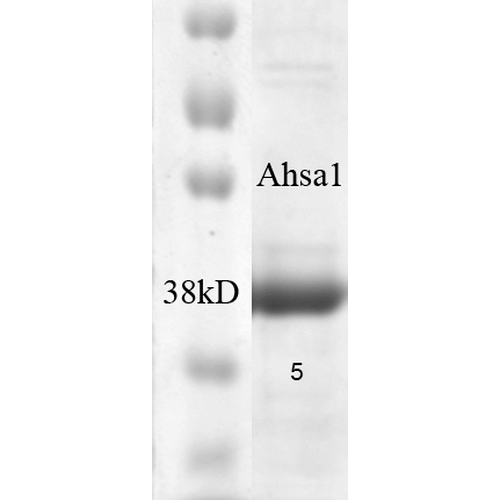SPR-314A SPR-311A SPR-309A SPR-300A SPR-314B SPR-311B SPR-309B SPR-300B SPR-314C SPR-311C SPR-309C SPR-300C +8
AHA1 Protein
Stressmarq Biosciences
DESCRIPTION
Human Recombinant AHA1 Protein
DETAILS
- Nature: Recombinant
- Purity: >90%
- Target: AHA1
- Category: Protein
- Conjugate: No tag
- References: 1. Hainzl O., Lapina M.C., Buchner J., Richter K. (2009) J Biol Chem. Epub. 2. Harst A., Lin H., Obermann W.M. (2005) Biochem J. 387 (pt.3): 789-796. 3. Lotz G.P., Brychzy A., Heinz S., Obermann W.M. (2008) J Cell Sci. 121(pt.5): 717-723. 4. Holmes J.L., Sharp S.Y., Hobbs S., Workman P. (2008) Cancer Res. 68(4): 1188-1197.
- Applications: WB | SDS-PAGE | Functional Assay
- Field of Use: Not for use in humans. Not for use in diagnostics or therapeutics. For research use only.
- Protein Size: ~38 kDa
- Purification: Multi-Step Purified
- Concentration: Lot/batch specific. See included datasheet.
- Research Areas: Cancer | Heat Shock | Cell Signaling | Protein Trafficking | Chaperone Proteins
- Storage Buffer: 20mM HEPES buffer pH7.2, 80mM NaCl, 10% glycerol
- Alternative Names: Aha1 Protein, SHSA1 Protein, HSPC322 Protein, p38 Protein
- Cite This Product: Human Recombinant AHA1 Protein (StressMarq Biosciences, Canada, Cat # SPR-300A)
- Expression System: E. coli
- Species Full Name: Human
- Amino Acid Sequence: SHMAKWGEGDPRWIVEERADATNVNNWHWTERDASNWSTDKLKTLFLAVQVQNEEGKCEVTEVSKLDGEASINNRKGKLIFFYEWSVKLNWTGTSKSGVQYKGHVEIPNLSDENSVDEVEISVSLAKDEPDTNLVALMKEEGVKLLREAMGIYISTLKTEFTQGMILPTMNGESVDPVGQPALKTEERKAKPAPSKTQARPVGVKIPTCKITLKETFLTSPEELYRVFTTQELVQAFTHAPATLEADRGGKFHMVDGNVSGEFTDLVPEKHIVMKWRFKSWPEGHFATITLTFIDKNGETELCMEGRGIPAPEEERTRQGWQRYYFEGIKQTFGYGARLF
- Storage Temperature: -20ºC
- Shipping Temperature: Blue Ice or 4ºC
- Cellular Localization: Cytoplasm
- Scientific Background: Aha1 is a member of the HSP90 cochaperone family, and is thought to stimulate HSP90 ATPase activity by competing with p23 and other co-chaperones for HSP90 binding (1, 2). It may affect a step in the endoplasmic reticulum to Golgi trafficking. Aha1 also interacts with HSPCA/HSP90 and with the cytoplasmic tail of the vesicular stomatistis virus glycoproteins (VSV G) (3). Aha1 is expressed in numerous tissues, including the brain, heart, skeletal muscle, and kidney, and at low levels, the liver and placenta. Aha1 might be a potential therapeutic strategy to increase sensitivity to HSP inhibitors (4).
- Certificate of Analysis: This product has been certified >90% pure using SDS PAGE analysis. 2uM SPR-300 generated a 9-fold ATPase activation of 2uM HSP90 (His-tagged HSP90 beta) in 33mM Hepes pH7.2, 30mM NaCl, 5mM MgCl2, 1mM DTT, 1.5mM ATP in a 100ul reaction at 37 degrees C. (This is an enzyme-linked ATP regeneration assay tracking loss of NADH absorbance at 340nm.)
Equivalent Items
| ... Loading
